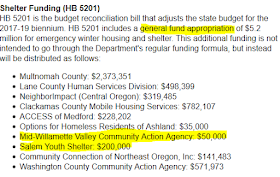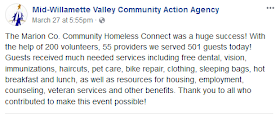Revised: January 2019
By Sarah Owens and Michael Livingston
 |
| 4/25/18 Public Hearing on UGM's CUP |
After nearly 3 hours of public hearing and "testimony" from roughly 25 individuals, the lawyers agreed to deadlines for the submission of rebuttal "evidence" and arguments, and the issue will come before Council again at its May 14 meeting.
Speaking in opposition to expansion were Jim Garaventa (Broadway Townhouses), Mirabel Ortiz (Broadway Place apartments), Dana Vugteveen (Salem Center), Loretta Miles (Salem Cinema), Chris Blackburn (Downtown Storage and Warehouse, NW Remarketing, Inc.). Ross Hopkins and former WU law prof, William Long, cast doubt on UGM's "changing numbers."
 |
| Christy Wood |
Former City Councilors Paul Wolf and Warren Bednarz, also spoke in support, along with Paul Young (Word of Life Fellowship), New Life Fellowship graduates Tom Ellis and Mike Potts, UGM resident Katrina Smiley, and UGM contractors, employees and volunteers Jeff Tross, Dan Clem, Rick Bratton, Jeannine Knight, Bruce Donohue and Lisa Campbell.
UGM, since 1953 the face of homelessness in downtown Salem, has helped a lot of people, women as well as men.
Paul Young said UGM has an annual budget of $4M. It doesn't take any government money, a point of pride for many.
Everyone who spoke agreed that the number of people living on Salem's streets has been growing. Rick Bratton said UGM turned away 2,500 men in 2017. The new facility will have 224 emergency beds (about 30 over its current wintertime capacity), 76 New Life Fellowship beds (up from 48), and cost $15M to build. Dick Withnell assured Council that the the money will be there.
 |
| 345 Commercial Street, September 2017 |
Dan Clem told Council that, currently, men from outside the area may stay at the shelter only two weeks, unless they join the New Life Fellowship.
But, it was not just the UGM guests that concerned opponents. It was all the unsavory people who congregate outside the mission during the day; the people waiting to have a meal or a shower, or looking to sell drugs, or maybe steal something. It's that prospect, that "likely adverse impact", that so concerned them. Because, honestly, no one wants to have what's now at 345 Commercial Street in their block.
Loretta Miles tried to tell Council the opposition wasn't NIMBYism, but it quite obviously was. Opponents claimed nothing for the 700-800 block of Commercial that made it uniquely unsuited for a men's shelter. Nor could they deny the move had been planned a very long time. We're talking years.
 |
| Mr. Grillo, for the appellant |
"Where you been, Dave? Don't you talk to people? I can take your money, but you don't need a lawyer, 'cause this thing is all but here. And these folks you don't talk to? These are your neighbors, Dave. Go talk to your neighbors. Tell them your concerns, work something out. Ain't no case here."
Unfortunately, however, Mr. Grillo did take Mr. Glennie's money, so it's kind of sad that Glennie
 |
| Mr. Glennie, the appellant |
Glennie told the Council he thought capacity should be limited to 100, with some winter overflow capacity. He apparently didn't realize that limiting shelter capacity would effectively prevent the enforcement of the City's anti-camping bans. A decent lawyer would have advised him he needed a different strategy.
Almost by way of friendly advice (in that it seemed to be unrelated to his appeal) Glennie advised the Council that "the City itself" needs to provide its homeless residents what he called a "hygiene center", a building with toilets, showers, laundry facilities and storage for the personal effects, for both men and women, saying he came to this realization after talking with Paul Logan of Northwest Human Services, and Jon Reeves, of the "Mid-Willamette Valley Council, Community Action Agency." The irony that Jon Reeves, who closed MWVCAA's homeless day shelter last June and has yet to reopen it, should be the source of such advice appeared lost on Mr. Glennie, but perhaps not the Council.
About 100 showed up for the hearing, 27 commented. The record was left open a few more days, to be followed by arguments. The revised staff recommendation was to adopt the additional conditions offered by UGM (see below) and require a photometric (lighting) plan as a tenth condition.]
 |





















